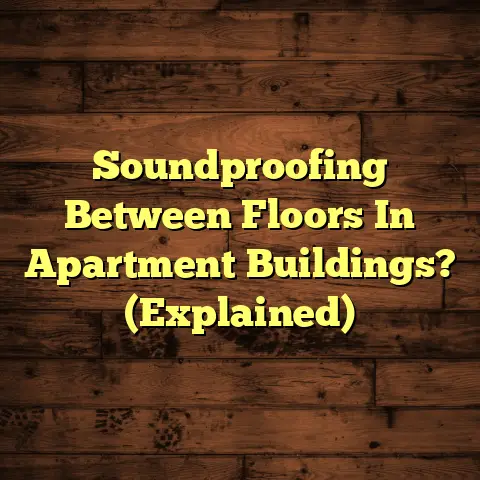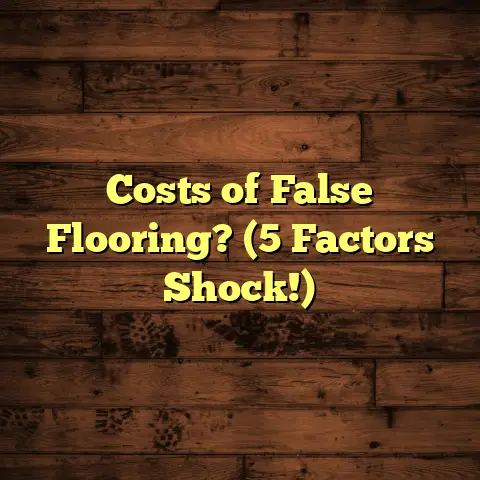Soundproof A Floor? (4 Steps, Stop Noise Now!)
Remember those lazy summer afternoons as a kid?
Sunlight streaming through the window, a book in my lap, lost in another world.
But even then, the peace was often shattered.
Footsteps thumping from the upstairs neighbors, the rumble of traffic outside, the constant creak of the old floorboards.
It wasn’t always terrible, but it definitely took away from the tranquility I craved.
Then there were the times we visited my grandparents. Their house was a haven.
Quiet. Calm. A place where you could actually hear yourself think.
That stark contrast stuck with me. It made me realize how much noise impacts our lives.
That’s why, as a flooring contractor for over 15 years, I’ve become passionate about soundproofing. It’s not just about construction; it’s about crafting a sanctuary. A space where you can truly relax, focus, and connect.
And that’s what I want to help you achieve.
1. Understanding Noise Transmission
Okay, let’s get down to brass tacks.
What exactly is noise transmission?
Simply put, it’s how sound travels from one place to another. Think of it like this: sound waves are like ripples in a pond.
They need a medium to travel through, and in our homes, that medium is often the floor.
Now, there are two main culprits when it comes to floor noise: impact noise and airborne noise.
Impact noise is what you hear when someone drops something, walks in heels, or your dog is doing zoomies.
It’s a direct vibration that travels through the structure.
Airborne noise is sound that travels through the air, like conversations, music, or the TV.
This type of noise can seep through gaps and cracks in the floor and ceiling.
Both types can be disruptive, especially in multi-story buildings. I’ve had clients who were losing sleep because of their neighbor’s late-night movie watching!
But why does noise bother us so much?
Well, studies have shown that excessive noise can lead to stress, anxiety, and even decreased productivity.
Think about it: how easy is it to concentrate when you’re constantly distracted by noise?
According to the EPA, prolonged exposure to noise above 65 decibels can be harmful.
That’s about the level of a normal conversation!
Soundproofing isn’t just a luxury; it’s an investment in your well-being. It can transform your home from a source of stress into a haven of peace.
2. Assessing the Current Flooring Situation
Alright, before we start tearing things up, we need to figure out what we’re dealing with.
First, take a good look at your floors.
Where is the noise the most bothersome?
Is it in the living room, where you’re trying to relax and watch TV?
Or maybe it’s in the bedroom, where you’re trying to sleep?
Identifying these problem areas will help you focus your soundproofing efforts.
Next, let’s do a little noise test.
It doesn’t need to be fancy.
Have someone walk around upstairs while you listen from below.
Pay attention to the types of sounds you hear.
Are they sharp and distinct, like footsteps?
Or more muffled and general, like voices?
You can also try tapping on the floor and listening for echoes.
A hollow sound usually indicates that there’s less material to absorb sound.
This simple test will give you a baseline for measuring your success later on.
Finally, let’s identify the type of flooring you currently have.
This is crucial because different flooring materials have different soundproofing properties.
-
Hardwood: Looks great, but not the best for sound absorption.
-
Laminate: Similar to hardwood, can be quite noisy.
-
Tile: Even worse than hardwood, as it’s very dense and reflective.
-
Carpet: The best of the bunch, as it absorbs sound naturally.
Knowing what you’re working with will help you choose the right soundproofing materials and techniques.
3. Four Steps to Soundproof a Floor
Okay, time to get our hands dirty!
Here’s my tried-and-true four-step process for soundproofing a floor.
Step 1: Choose the Right Soundproofing Material
This is where the magic happens.
There are a ton of different soundproofing materials out there, but here are a few of my favorites:
-
Acoustic Underlayment: This is a layer of material that goes between the subfloor and the finished floor. It’s designed to absorb impact noise and reduce airborne noise. I like using rubber or cork underlayment, as they’re both very effective.
-
Soundproofing Mats: These are thicker and more dense than underlayment. They’re great for blocking out even more noise. I often use them in home theaters or music studios.
-
Carpets: As I mentioned earlier, carpet is a natural sound absorber. Opt for a thick pile carpet with a dense pad underneath for maximum soundproofing.
So, which material should you choose?
Well, it depends on your budget, the type of noise you’re trying to block, and the type of flooring you have.
Acoustic underlayment is a good all-around option, while soundproofing mats are better for more extreme noise problems.
Carpet is a great choice if you like the look and feel of it.
Here’s a quick comparison table:
| Material | Pros | Cons | Cost |
|---|---|---|---|
| Acoustic Underlayment | Good all-around, relatively inexpensive, easy to install | Not as effective as mats for extreme noise | \$1-3/sq ft |
| Soundproofing Mats | Very effective at blocking noise, durable | More expensive, can be difficult to install | \$3-7/sq ft |
| Carpets | Natural sound absorber, comfortable, adds warmth to the room | Can be difficult to clean, not suitable for all rooms | \$2-10/sq ft |
Step 2: Prepare the Floor Surface
Before you start installing anything, you need to make sure the floor is clean, level, and free of any debris.
This is crucial for ensuring a good bond between the soundproofing material and the subfloor.
Start by sweeping or vacuuming the floor thoroughly.
Then, use a damp mop to clean any remaining dirt or grime.
If there are any cracks or holes in the subfloor, fill them with a patching compound.
You can find this at any hardware store.
Finally, use a level to check for any uneven spots.
If there are any, you’ll need to sand them down or use a self-leveling compound to create a smooth surface.
Step 3: Installation of Soundproofing Materials
Okay, now for the fun part!
The installation process will vary depending on the type of material you’re using, but here are some general tips:
-
Acoustic Underlayment: Roll out the underlayment and cut it to fit the room. Use a utility knife to trim any excess. Apply adhesive to the subfloor and then carefully lay the underlayment on top. Use a roller to press it firmly into place.
-
Soundproofing Mats: These are usually installed in the same way as underlayment. However, they may require a stronger adhesive. Be sure to follow the manufacturer’s instructions.
-
Carpets: If you’re installing new carpet, start by laying down a new carpet pad. This will add an extra layer of soundproofing. Then, install the carpet according to the manufacturer’s instructions.
No matter which material you’re using, make sure to overlap the seams slightly to prevent any gaps.
Gaps are the enemy of soundproofing!
Step 4: Finishing Touches and Testing Effectiveness
Once you’ve installed the soundproofing material, it’s time to finish the job.
If you’re using underlayment or soundproofing mats, you’ll need to install a new layer of flooring on top.
This could be anything from hardwood to laminate to tile.
Just make sure to choose a material that complements the soundproofing layer.
For example, if you’re using a thick soundproofing mat, you might want to choose a thinner flooring material to avoid making the floor too high.
Once the new flooring is installed, it’s time to test the effectiveness of your soundproofing.
Have someone walk around upstairs again while you listen from below.
Do you notice a difference?
Hopefully, the noise will be significantly reduced.
If not, you may need to add another layer of soundproofing or look for any gaps that you might have missed.
4. Additional Benefits of Soundproofing
Beyond just reducing noise, soundproofing your floor can also offer a few other benefits.
-
Energy Efficiency: Soundproofing materials can also help to insulate your home, keeping it warmer in the winter and cooler in the summer. This can save you money on your energy bills.
-
Improved Insulation: Soundproofing materials can also help to block out drafts and keep your home more comfortable.
-
Increased Property Value: A well- soundproofed home is more attractive to buyers, especially in multi-story buildings. This can increase the value of your property.
I remember one client of mine, Sarah, who lived in a condo with paper-thin walls.
She was constantly disturbed by her neighbor’s loud music and parties.
After soundproofing her floors and walls, she told me that it was like living in a different world.
She could finally relax and enjoy her home without being disturbed by noise.
And as a bonus, she also noticed a significant decrease in her energy bills!
Conclusion: Creating Your Peaceful Sanctuary
So, there you have it.
My four-step process for soundproofing a floor.
It’s not always easy, but it’s definitely worth it.
A quiet home is a foundation for well-being.
It’s a place where you can relax, focus, and connect with loved ones.
It’s a place where you can escape the stresses of the outside world and recharge your batteries.
Remember those childhood memories I talked about at the beginning?
The ones where I longed for a peaceful home?
Well, you can create that for yourself.
Take action today and start soundproofing your floors.
You won’t regret it.
Think of the moments you’ll create:
-
The quiet evenings spent reading a book.
-
The deep conversations with loved ones.
-
The restful nights of sleep.
These are the memories that make a house a home.
And they’re all within your reach.





